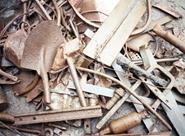Scrap Prices North America

Schnitzer Steel Industries to Restructure Divisons
Written by Sandy Williams
April 6, 2015
Schnitzer Steel Industries plans a “cost reduction, capacity reduction and productivity initiative” to improve its financial performance by $60 million annually by the end of 2016. In addition, the Auto Parts and Metals Recycling Business will be consolidated into a single division by the end of FY 2015.
“In the face of steep declines in commodity prices, we are taking deliberate and substantial steps to continue to lower our operating costs and generate positive cash flow,” said Tamara Lundgren, President and Chief Executive Officer.
Schnitzer Steel reported a net loss of $196 million in second quarter, ending Feb. 28, 2016, as compared to a net income of $2 million in the same quarter 2014. Results included 44 million in non-cash impairment charges and $8 million in restructuring and exit costs due to the idling or closing of operations in the Auto Parts and Recycling businesses.
Second quarter recycled metals prices fell 30 percent, or as much as $100 per ton, from levels in first quarter. Ferrous scrap sales totaled $243 million for Q2 compared to $338 million the prior quarter and $409 million in Q2 2014.
“These significantly lower prices have been driven by softer global steel markets due to overproduction, the strong dollar, lower iron ore prices, and weaker demand in end-markets, including the energy, agriculture and mining sectors. In addition, during the quarter our business activity was impacted by harsh winter weather in the Northeast and Midwest which impacted retail sales in our Auto Parts Business and supply flows in our Metals Recycling Business, and by a labor slowdown at the West Coast ports,” reported Schnitzer in the company’s second quarter 2015 earnings results.
Schnitzer expects about 50 percent of savings to come from the Metals Recycling business through equipment idling, reduced depreciation and SG&A reductions. The other 40 percent will come from store closings in the Auto Parts business, SG&A reductions and productivity improvements. One fourth of the savings will be achieved by Q4 2015. The restructuring is expected to incur charges of approximately $10 million.
Ferrous scrap sales of 760 thousand tons were reported in second quarter, down 20 percent from Q1 and down 27 percent from the prior year, due to weaker export demand and the impact of lower pricing on supply and shipments. Nonferrous shipments decreased 20 percent y/y and 15 percent sequentially. Operating margins were down and adjusted $2 per ton in Q2.
In the Auto Parts segment, revenues were down 9 percent from 2014 and 15 percent from first quarter. The declines were attributed to declining commodity prices and weaker retail sales due to the harsh winter in the Midwest and Northeast.
Finished steel sale volumes increased 14 percent year over year to 131,000 tons in second quarter for sales of $93 million. Average net price for finished steel products dropped $25 per ton compared to 2Q 2014 and was down $32 per ton sequentially. The drop was primarily due to the plunge in scrap pricing and to a lesser degree, the impact of imports. The rolling mill utilization rate was at 76 percent, up from 67 percent the prior year and 72 percent in Q1.

Sandy Williams
Read more from Sandy WilliamsLatest in Scrap Prices North America

HRC vs. scrap spread widens over $150/ton in March
The HRC vs. prime scrap spread increased again in March.

HRC vs. prime scrap spread increases in February
The price spread between hot-rolled coil (HRC) and prime scrap widened in February ahead of the implementation of President Trump’s tariffs on steel.
HRC vs. prime scrap spread narrows again in January
The price spread between hot-rolled coil (HRC) and prime scrap continued to narrow in January, according to SMU’s most recent pricing data. While SMU’s average HRC price edged down week over week (w/w), it rose compared to a month ago. The January price for busheling also increased from December. Our average HRC price as of […]

HRC vs. prime scrap spread flat in November
The price spread between hot-rolled coil (HRC) and prime scrap remained the same in November as both tags were at the levels seen a month earlier, according to SMU’s most recent pricing data.

HRC vs. busheling spread narrows slightly in October
The price spread between hot-rolled coil (HRC) and prime scrap narrowed marginally in October, according to SMU’s most recent pricing data.
